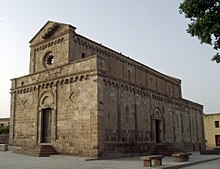Judicate of Cagliari
Judicate of Cagliari Iudicatus Karalitanus Càlaris | |||||||||||
|---|---|---|---|---|---|---|---|---|---|---|---|
| 1020–1258 | |||||||||||
Latin | |||||||||||
| Religion | Roman Catholic | ||||||||||
| Government | Judicate (kingdom) | ||||||||||
| Judge | |||||||||||
• 1089 – 1102 | Constantine I of Cagliari | ||||||||||
• 1214–1232 | Benedetta of Cagliari | ||||||||||
• 1256 – 1258 | William III of Cagliari | ||||||||||
| History | |||||||||||
• Established | 1020 | ||||||||||
• Disestablished | 1258 | ||||||||||
| |||||||||||
The Judicate of Cagliari (Sardinian: Judicadu de Càralis / Càlaris, Italian: Giudicato di Cagliari) was one of the four kingdoms or judicates (iudicati, literally "judgeship") into which Sardinia was divided during the Middle Ages.
The Judicate of Cagliari occupied the entire southern portion of the island and was composed of thirteen subdivisions called curatoriae. It bordered the judicates of Arborea to the northwest and Logudoro and Gallura to the northeast.
Origins and extent
The exact date of founding of the Judicate of Cagliari is unknown. After the Byzantine Empire's conquest of Sardinia in 534, the island became one of the provinces of the Exarchate of Africa and was governed by a magistrate of the empire said Iudex Provinciae, resident in Cagliari.
Sardinia remained a
The Judicate of Cagliari comprised a large area of the
The first judges


The first giudice well known to history is
Among the traditions of these early giudici was that of confirming one of one's predecessor's acts, usually donations of land or grants of privileges.
House of Massa and Pisan domination


Constantine II's daughter succeeded him with her husband
William spent his reign (1188 – 1214) in constant wars with Arborea, Gallura, and Logudoro. He arrested and imprisoned the judge of Arborea,
See also
- List of judges (judikes) of Cagliari
References
- ^ Solmi A., Studi storici sulle istituzioni della Sardegna nel Medioevo, Cagliari 1917.
Sources
- Dizionario Biografico degli Italiani. Rome, 1963 – Present.
- Nowé, Laura Sannia. Dai "lumi" dalla patria Italiana: Cultura letteraria sarda. Mucchi Editore: Modena, 1996.
- Casula, Francesco. "The History of Sardinia." Sardinia Tourist Board. 1989.
- Solmi A., Studi storici sulle istituzioni della Sardegna nel Medioevo, Cagliari 1917.

